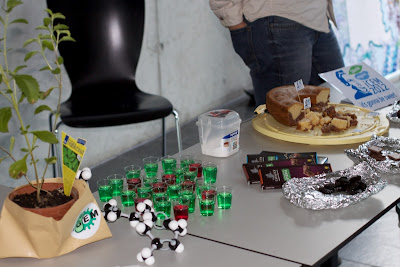Team:Frankfurt
From 2013.igem.org

Steviomyces - it's gonna be sweet
Project Description

The Stevia plant produces several sweeteners known as Steviolglycosides which have only recently been admitted as a foodadditive in the European Union. The iGEM-Team Frankfurt 2013 searches for ways to transfer the pathway of the plant into Saccharomyces cerevisiae in order to make stevia production possible with both lower effort and lower costs. Several of known problems with carbohydratesweeteners like diabetes or caries could be overcome by the Steviolglycosides which are produced by Stevia rebaudiana. We are building upon results gained from last year's competition which gave us the possibility to transfer a mevalonat plasmid into yeast to increase the production of a steviol-precursor Geranylgeranyl-diphosphate. This year we're searching for a further reconstruction of the pathway and transfering the 2nd plasmid for synthesis of Steviol from Geranylgeranyl-diphosphate into yeast. Thus the whole pathway can take place in a microbial organism and easify the production by lowering the costs.
Therefore, we aim to develop biobricked pathway expressing all necessary genes for rebaudioside A production in common baker's yeast Saccharomyces cerevisae, a well known, safe organism used in food production for millenia. As a precursor for the diterpene steviol is geranylgeranyl pyrophosphate (GGPP), an intermediate of the mevalonate pathway and the steroid metabolism, we plan to overexpress certain key enzymes of this pathway in order to create a favorable amount of educts for steviol biosynthesis, as literature research hinted at this particular bottleneck. Furthermore, we aim to clone, biobrick and express the enzymes for a bifunctional cyclase from Gibberella fujikuroi catalyzing a two step cyclisation from GGPP to ent-kaurene, the ent-kaurene oxidase, as well from Gibberella fujikuroi, catalyzing the reaction from ent-kaurene to ent-kaurenoic acid, and a ent-kaurenoic acid hydroxylase from Stevia rebaudiana, catalyzing the final step producing steviol. Finally, we will try to introduce certain uracil-glycosil transferases (UGTs) from Stevia rebaudiana, catalyzing various glycosilation reactions necessary to produce rebaudiosides. As one UGT believed to be necessary for rebaudioside A production is not yet known, we might conduct experiments to find this particular UGT or a viable substitute.
Basing upon a microorganism producing stevia sweetener, other problems such as purification and product recovery might be improved biotechnologically. Furthermore, the biobricks for stevia production can be used in other organisms and for other applications.
Aims and Achievements of our Project
In our participation in the 2012 iGEM Competition we were able to successfully test the gen assembly method via gap repair cloning and construct a plasmid for increased Geranylgeranyl Pyrophosphate production and transformed it into yeast. We presented our ideas to the general, professional and university public and discussed them both with regard to technical, social and ethical implications. Last but not least we were able to gain financial, technical and administrative support and overcame the obstacles to create an iGEM Team at Goethe University where iGEM and its concepts are only recently known. We want to establish the iGEM competition as an fixed part of the educational proposals at the Goethe University.
This years obectives were on the one hand to transform the plasmids,the one for mevalonate and the one for steviol in yeast and on the other hand prove the overexpression via GC-MS.In the next years competition we will try to analyze the metabolome of our modified pathways and do protein assays. Additionally we want to create the final steps to Steviol in yeast and also give some attention in the production of different Diterpene compounts.
 "
"